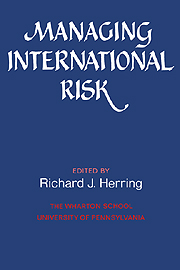 Managing International Risk
Managing International Risk Published online by Cambridge University Press: 07 May 2010
My task is to reconcile the academic and practical views. The academic speakers have emphasized the growing economic and political risks, and Helen Hughes says the amount of risk is highly exaggerated or at least is not enough to get too excited about. Let me say this: My own instinct is that there is a considerably higher risk today than ten or twenty years ago. Twenty years ago, we were in the fixed exchange rate system. We had low rates of inflation and low interest rates, which were fairly stable, and we were lending mainly to industrial countries whose balances of payments were in reasonably good condition and who had also fairly good adjustment policies.
Today, we have very volatile exchange rates, very high rates of inflation, and an international lending system that is much larger and more widespread than ten years ago.
When preparing these comments, I asked my management whether we had higher risks now than a decade ago. The answer was yes, but not in the sense that we as economists would think. From a bank's balance sheet and profit and loss account, the risks in the past decade have been in the area of interest rates and exchange rates. The impact on the banks' earnings of these variations in exchange and interest rates has been far greater than the risks associated with international lending. I should add that corporate management is spending a great deal more time on weighing exchange and interest rate risks than on determining country risk. Historically, the losses in the area of sovereign lending have been remarkably small.
To save this book to your Kindle, first ensure [email protected] is added to your Approved Personal Document E-mail List under your Personal Document Settings on the Manage Your Content and Devices page of your Amazon account. Then enter the ‘name’ part of your Kindle email address below. Find out more about saving to your Kindle.
Note you can select to save to either the @free.kindle.com or @kindle.com variations. ‘@free.kindle.com’ emails are free but can only be saved to your device when it is connected to wi-fi. ‘@kindle.com’ emails can be delivered even when you are not connected to wi-fi, but note that service fees apply.
Find out more about the Kindle Personal Document Service.
To save content items to your account, please confirm that you agree to abide by our usage policies. If this is the first time you use this feature, you will be asked to authorise Cambridge Core to connect with your account. Find out more about saving content to Dropbox.
To save content items to your account, please confirm that you agree to abide by our usage policies. If this is the first time you use this feature, you will be asked to authorise Cambridge Core to connect with your account. Find out more about saving content to Google Drive.